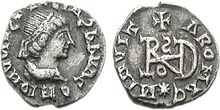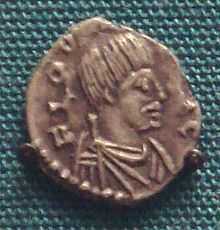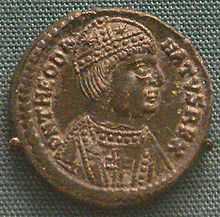Theoderic the Great
| Theoderic | |
|---|---|
| King of Ostrogoths | |
 Quarter Siliqua featuring Theoderic, c. AD 491–501 | |
| Spouse | Audofleda |
| Issue | Amalasuntha |
| Father | Theodemir |
| Mother | Ereleuva |
| Born | 454 |
| Died | 526 (aged 71–72) |
| Religion | Arianism |
Theoderic the Great (thē-ŏd'ə-rik, Gothic: Þiudareiks; Latin: Flāvius Theodericus; Greek: Θευδέριχος, Theuderikhos; Old English: Þēodrīc; Old Norse: Þjōðrēkr, Þīðrēkr; 454 – August 30, 526), often referred to as Theodoric, was king of the Germanic Ostrogoths (475–526),[1] ruler of Italy (493–526), regent of the Visigoths (511–526), and a patricius of the Eastern Roman Empire. His Gothic name Þiudareiks translates into "people-king" or "ruler of the people".[2] Theodoric was born in Pannonia in 454, after his people had defeated the Huns at the Battle of Nedao. His father was King Theodemir, a Germanic Amali nobleman, and his mother was Ereleuva. Theodoric grew up as a hostage in Constantinople, receiving a privileged education, and he succeeded his father as leader of the Pannonian Ostrogoths in 473.[3] Settling his people in lower Moesia, Theoderic came into conflict with Thracian Ostrogoths led by Theodoric Strabo, whom he eventually supplanted, uniting the peoples in 484.
Byzantine Emperor Zeno subsequently gave him the title of Patrician and the office of Magister militum (master of the soldiers), and even appointed him as Roman Consul. Seeking further gains, Theoderic frequently ravaged the provinces of the Eastern Roman Empire, eventually threatening Constantinople itself. In 488, Emperor Zeno ordered Theoderic to overthrow the German Foederatus Odoacer, who had likewise been made patrician and even King of Italy, but who had since betrayed Zeno, supporting the rebellious Leontius. After a victorious three-year war, Theoderic killed Odoacer with his own hands, settled his 100,000 to 200,000 people in Italy, and founded an Ostrogothic Kingdom based in Ravenna. While he promoted separation between the Arian Ostrogoths and the Roman population, Theoderic stressed the importance of racial harmony, though intermarriage was outlawed.[4] Seeking to restore the glory of Ancient Rome, he ruled Italy in its most peaceful and prosperous period since Valentinian, until his death in 526. Memories of his reign made him a hero of German legend as Dietrich von Bern.
Youth
The man who would later rule under the name of Theoderic was born in 454 AD, on the banks of the Neusiedler See near Carnuntum. This was just a year after the Ostrogoths had thrown off nearly a century of domination by the Huns. The son of the King Theodemir and Ereleuva, Theoderic went to Constantinople as a young boy, as a hostage to secure the Ostrogoths' compliance with a treaty Theodemir had concluded with the Byzantine Emperor Leo (ruled 457–474).
He lived as a hostage at the court of Constantinople for many years and learned a great deal about Roman government and military tactics, which served him well when he became the Gothic ruler of a mixed but largely Romanized "barbarian people". Treated with favor by the Emperors Leo I and Zeno (ruled 474–475 and 476–491), he became magister militum (Master of Soldiers) in 483, and one year later he became consul. Afterwards, he returned to live among the Ostrogoths when he was 31 years old and became their king in 488.
Reign
| ||||||

At the time, the Ostrogoths were settled in Byzantine territory as foederati (allies) of the Romans, but were becoming restless and increasingly difficult for Zeno to manage. Not long after Theoderic became king, the two men worked out an arrangement beneficial to both sides. The Ostrogoths needed a place to live, and Zeno was having serious problems with Odoacer, the King of Italy who had come to power in 476. Ostensibly a viceroy for Zeno, Odoacer was menacing Byzantine territory and not respecting the rights of Roman citizens in Italy. At Zeno's encouragement, Theoderic invaded Odoacer's kingdom.
Theoderic came with his army to Italy in 488, where he won the battles of Isonzo and Verona in 489 and at the Adda in 490. In 493 he took Ravenna. On February 2, 493, Theoderic and Odoacer signed a treaty that assured both parties would rule over Italy. A banquet was organised in order to celebrate this treaty. It was at this banquet that Theoderic, after making a toast, killed Odoacer with his own hands.

Like Odoacer, Theoderic was ostensibly only a viceroy for the emperor in Constantinople. In reality, he was able to avoid imperial supervision, and dealings between the emperor and Theoderic were as equals. Unlike Odoacer, however, Theoderic respected the agreement he had made and allowed Roman citizens within his kingdom to be subject to Roman law and the Roman judicial system. The Goths, meanwhile, lived under their own laws and customs. In 519, when a mob had burned down the synagogues of Ravenna, Theoderic ordered the town to rebuild them at its own expense.
Theoderic the Great sought alliances with, or hegemony over, the other Germanic kingdoms in the west. He allied with the Franks by his marriage to Audofleda, sister of Clovis I, and married his own female relatives to princes or kings of the Visigoths, Vandals and Burgundians. He stopped the Vandals from raiding his territories by threatening the weak Vandal king Thrasamund with invasion, and sent a guard of 5,000 troops with his sister Amalafrida when she married Thrasamund in 500. For much of his reign, Theoderic was the de facto king of the Visigoths as well, becoming regent for the infant Visigothic king, his grandson Amalaric, following the defeat of Alaric II by the Franks under Clovis in 507. The Franks were able to wrest control of Aquitaine from the Visigoths, but otherwise Theoderic was able to defeat their incursions.
Theoderic's achievements began to unravel even before his death. He had married off his daughter Amalasuntha to the Visigoth Eutharic, but Eutharic died in August 522 or 523, so no lasting dynastic connection of Ostrogoths and Visigoths was established. In 522, the Catholic Burgundian king Sigismund killed his own son, Theoderic's grandson, Sergeric. Theoderic retaliated by invading the Burgundian kingdom and then annexing its southern part, probably in 523. The rest was ruled by Sigismund's Arian brother Godomar, under Gothic protection against the Franks who had captured Sigismund. This brought the territory ruled by Theoderic to its height (see map), but in 523 or 524 the new Catholic Vandal king Hilderic imprisoned Amalafrida and killed her Gothic guard. Theoderic was planning an expedition to restore his power over the Vandal kingdom when he died in 526.

Family and progeny
Theoderic was married once.
He had a concubine in Moesia, name unknown, with whom he had two daughters:
- Theodegotha (ca. 473 – ?). In 494, she was married to Alaric II as a part of her father's alliance with the Visigoths.
- Ostrogotha or Arevagni (ca. 475 – ?). In 494 or 496, she was married to the king Sigismund of Burgundy as a part of her father's alliance with the Burgundians.
By his marriage to Audofleda in 493 he had one daughter:
- Amalasuntha, Queen of the Goths. She was married to Eutharic and had two children: Athalaric and Matasuntha (the latter being married to Witiges first, then, after Witiges' death, married to Germanus Justinus, neither had children). Any hope for a reconciliation between the Goths and the Romans in the person of a Gotho-Roman Emperor from this family lineage was shattered.
After his death in Ravenna in 526, Theoderic was succeeded by his grandson Athalaric. Athalaric was at first represented by his mother Amalasuntha, who was a regent queen from 526 until 534. The kingdom of the Ostrogoths, however, began to wane and was conquered by Justinian I starting after the rebellion of 535 and finally ending in 553 with the Battle of Mons Lactarius.
Religion
In about 520 the philosopher Boethius became his magister officiorum (head of all the government and court services). Boethius was a man of science, a dedicated Hellenist bent on translating all the works of Aristotle into Latin and harmonizing them with the works of Plato. Eventually Boethius fell out of favor with Theoderic, perhaps out of a suspicion that he was in sympathy with Justin, emperor of the East, for Arian Theoderic was always somewhat of an outsider among Nicaean Christians. Theoderic ordered Boethius executed in 525.
In the meantime Cassiodorus had succeeded Boethius as magister in 523. The pliant historian and courtier could be counted on to provide refined touches to official correspondence. "To the monarch you [Cassiodorus] were a friendly judge and an honored intimate. For when he got free of his official cares he looked to your conversation for the precepts of the sages, that he might make himself a worthy equal to the great men of old. Ever curious, he wanted to hear about the courses of the stars, the tides of the sea, and legendary fountains, that his earnest study of natural science might make him seem to be a veritable philosopher in the purple" (Cassiodorus' letterbook, Variae 9.24.8). The gulf was widening between the ancient senatorial aristocracy whose center was Rome and the adherents of Gothic rule at Ravenna: other distinguished public figures followed Boethius to the block.
Theoderic in his final years was no longer the disengaged Arian patron of religious toleration that he had seemed earlier in his reign. "Indeed, his death cut short what could well have developed into a major persecution of Catholic churches in retaliation for measures taken by Justinian in Constantinople against Arians there"[5]
Theoderic was of Arian faith. At the end of his reign quarrels arose with his Roman subjects and the Byzantine emperor Justin I over the Arianism issue. Relations between the two nations deteriorated, although Theoderic's ability dissuaded the Byzantines from waging war against him. After his death, that reluctance faded quickly.
Legacy
Mausoleum
Theoderic the Great was interred in Ravenna, but his bones were scattered and his mausoleum was converted to a church after Belisarius conquered the city in 540.[6] His mausoleum is one of the finest monuments in Ravenna, but his equestrian statue, the Regisole, which also once graced the city, was later removed and ultimately destroyed during the French Revolution.
Medieval reception
Theoderich as Dietrich von Bern is an important figure in Middle High German literature, and as Þiðrekr in Old Icelandic.
Notes
- ↑ Grun, Bernard (1991) [1946]. The Timetable of History (New Third Revised Edition ed.). New York: Simon & Schuster. pp. 30–31. ISBN 0-671-74271-X.
- ↑ Langer, William Leonard (1968). "Italy, 489–554". An Encyclopedia of World History. Harrap. p. 159.
Thiudareiks (ruler of the people)
- ↑ Thomas burns, a history of ostrogoths p57
- ↑ Theodoric led the Ostrogothic invasion of Italy (supported by elements of the Rugii). During the course of four years of fighting, the invasion swept away Odoacer's Post-Imperial Romano-Gothic kingdom. In its place Theodoric created an Ostrogothic kingdom which held much of Italy until Byzantium began a re-conquest of the western empire in southern Italy. Despite the fact that the invasion had been devised by Emperor Zeno, the Ostrogoths ruled independently, and Theodoric and Zeno addressed each other as equals. Overtures to Byzantium were only made by some Ostrogoth leaders after Theodoric's death. A Roman consul was given nominal authority, and the two peoples lived together amicably, with Roman culture greatly influencing the barbarians. The Goths took one-third of the land while the Romans retained the rest. Each side observed their own laws, and intermarriage between Roman and Goth was forbidden. One area in which they didn't agree was in Christianity. The Ostrogoths were confirmed Arians, which the Catholics of the Roman Church found hard to stomach. Not all the Ostrogoths pursued this path into Italy and eventual Italianisation. A branch known as the Tauric Ostrogoths ventured further eastwards, ending up in Crimea by the end of the 5th century. They settled in the region and established an Eastern Germanic Gothic principality, later known as Doros. Additionally, some elements of the Gothic peoples in southern Germany formed part of the Bavarii confederation at the start of the 6th century. Germanic Tribes: Goths
- ↑ O'Donnell 1979, ch. 1.
- ↑ Trudy Ring; Robert M. Salkin; Sharon La Boda (1 January 1996). International Dictionary of Historic Places: Southern Europe. Taylor & Francis. pp. 556–. ISBN 978-1-884964-02-2. Retrieved 9 October 2010.
References
- Peter Heather, The Goths (Oxford, Blackwell, 1996).
- O'Donnell, James J. Cassiodorus. (Berkeley, University of California Press, 1979) .
- John Moorhead, Theoderic in Italy (Oxford: Oxford University Press, 1992).
- Andreas Goltz, Barbar - König - Tyrann. Das Bild Theoderichs des Großen in der Überlieferung des 5. bis 9. Jahrhunderts (Berlin: de Gruyter 2008) (Millenium-Studien zu Kultur und Geschichte des ersten Jahrtausends n. Chr., 12).
- Encyclopaedia Britannica 1911: "Dietrich of Bern"
- Rolf Badenhausen, "Merovingians by the Svava?": discussion based on the Skokloster Svava, Stockholm catalogued as Skokloster-Codex-I/115&116 quarto, E 9013.
- Theodoric the Great at MiddleAges.net
- Theodoric the Goth, 1897, by Thomas Hodgkin, from Project Gutenberg
- Theodoric the Great at the Catholic Encyclopedia
- Medieval Lands Project on Theoderic the Great, King of Italy
Related links
| Wikimedia Commons has media related to Theoderic the Great. |
| Preceded by Theodemir |
King of the Ostrogoths 474–526 |
Succeeded by Athalaric |
| Preceded by Odoacer |
King of Italy 493–526 | |
| Preceded by Anicius Acilius Aginatius Faustus, Post consulatum Trocundis (East) |
Consul of the Roman Empire 484 with Decius Marius Venantius Basilius |
Succeeded by Q. Aurelius Memmius Symmachus, Post consulatum Theoderici (East) |
| ||||||||||||||||||||||||||||
|


